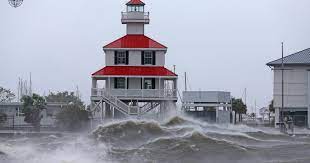Hurricane Ida battered the southern US state of Louisiana and plunged New Orleans into darkness, killing at least one person.
Ida slammed into the Louisiana coast as a Category 4 storm but weakened into a tropical storm on Monday. More than one million people in Louisiana and Mississippi were without power.
President Joe Biden described Ida as “life-threatening” and declared Louisiana a disaster area.
The hurricane was compared with Katrina, which devastated Louisiana exactly 16 years ago to the day, but it remains to be seen how much damage Ida inflicted.
The storm is expected to continue weakening as it moves over land with a predicted track taking it north over the central United States before veering eastward, reaching the mid-Atlantic region by Wednesday.
Here are the latest updates:
While Ida is sure to take a toll on the energy, chemical and shipping industries that have major hubs along the Gulf Coast, the impact on the overall US economy should be modest, economists have suggested.
Mark Zandi, chief economist at Moody’s Analytics, said the disruptions caused by Ida will likely lead him to downgrade his forecast for annual US economic growth in the July-September quarter by a few 10ths of a percentage point. But that economic loss could be reversed in the final quarter of the year as a result of the rebuilding from the hurricane’s damage that will likely follow.
“The key channel for Ida to impact the broader economy is through energy prices,” Zandi said. “We will have to see how much damage occurred to production in the Gulf and how long that production will stay offline.”
John Bel Edwards, governor of Louisiana, ordered people to stay home to avoid the dangerous situation in the aftermath of Hurricane Ida.
The National Weather Service issued warnings of storm surges and flash floods for several areas, including the town of Jean Lafitte, just south of New Orleans, where Mayor Tim Kerner said the rapidly rising waters had overtopped the 2.3-metre (7.5 feet) levees.
“Total devastation, catastrophic, our town levees have been overtopped,” Kerner told ABC-affiliate WGNO.
“We have anywhere between 75 to 200 people stranded” after a barge took out the swing bridge to the island.
“The winds are still too strong, we can’t put boats in the water to get to them. This is a very dangerous situation. I’ve never seen so much water in my life,” said Kerner.
Across southeast Louisiana, residents waited for daylight to be rescued from floodwaters and see how much damage was caused by Ida.
Levees failed or were overtopped in the maze of rivers and bayous south of New Orleans, threatening hundreds of homes. On social media, people posted their addresses and locations – directing search and rescue teams to their attics or rooftops.
Officials promised to start the massive rescue effort as the weather broke and the sun rose.
Hurricane Ida’s top winds slowed over Mississippi, 16 hours after blowing ashore in Louisiana as one of the most powerful hurricanes ever to strike the US mainland.
“We have now lost power, citywide! This is the time to continue to remain in your safe places. It isn’t a time to venture out,” New Orleans Mayor LaToya Cantrell said on Twitter.
Ida pushed so much water into the mouth of the Mississippi that it reversed the flow of the mighty river and blacked out New Orleans, taking down backup electricity for the city’s crucial pumping system.
Torrential rain kept falling as the storm slowly moved north, with up to 2 feet (60cm) expected in places, as reports of flooded roads and homes multiplied.
Copyright TRUSTAFRICA NEWS.
All rights reserved. This material, and other digital content on this website, may not be reproduced, published, broadcast, rewritten or redistributed in whole or in part without prior express written permission from TRUSTAFRICA NEWS.
Contact: [email protected]






